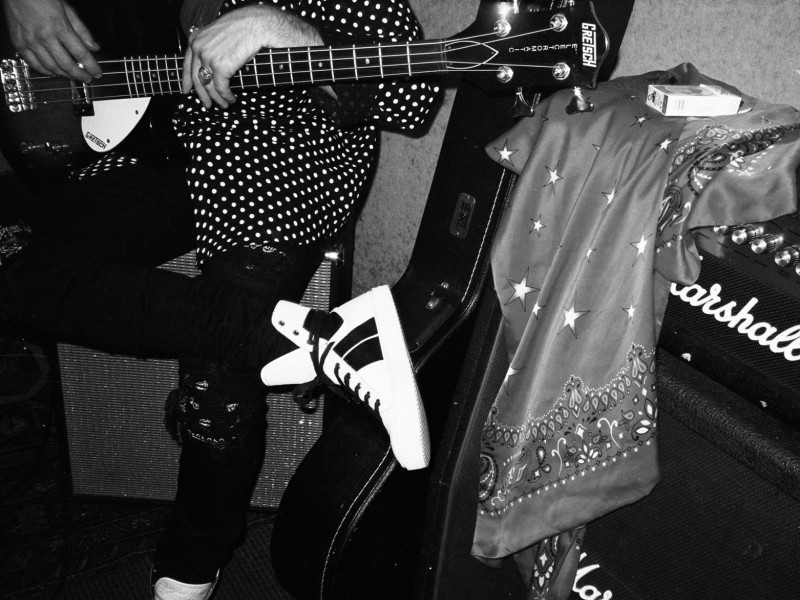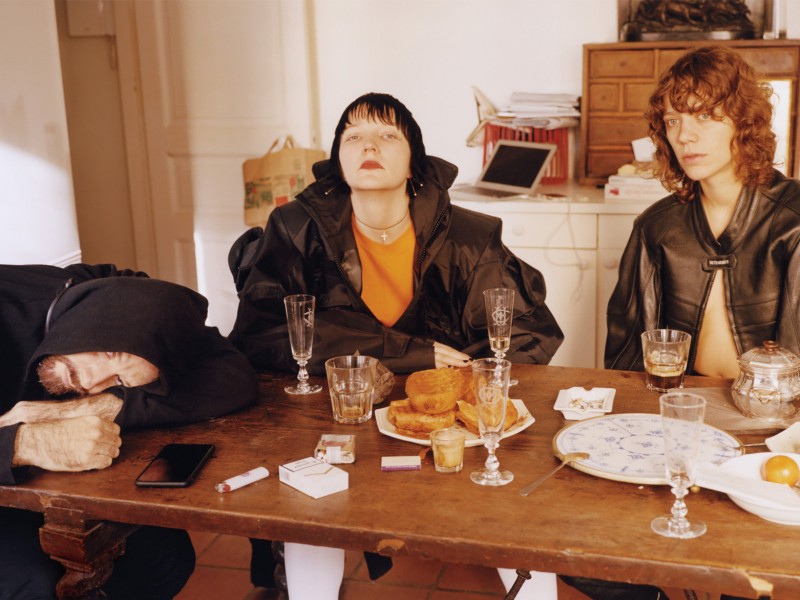When a designer friend of mine first came across the words Collier Schorr, she took them not as a name but as a kind of Lorem Ipsum; shapely letters to use as placeholder text as she drafted her layouts. The syllables are mutable—both soft and hard, and ambiguous. To those unfamiliar with the American artist and fashion photographer Collier Schorr, the name does not conjure up any particular imagery. Much like the artist, both are open to interpretation.
Schorr doesn’t impose too much on her images. She is known for her portraits of adolescent men and women, which often charge photographic realism with youthful fantasy and sparks of fiction. Her gaze feels open and unpremeditated, her presence—ostensibly at least—is lightly felt in the frame. She allows the viewer to draw their own conclusions. For example, is a photograph of young wrestlers caught mid-flight—the use of flash highlighting their bodies against a pitch black background—a straight-up documentation of that match? Does it reveal a performance, dance, or poetry in motion? Or is it a sculptural, emotionally charged portrait of youth and male beauty? Perhaps, with its chiaroscuro effect, it could also evoke a Caravaggio and all the associated religious and spiritual connotations.
Beginning in 1999 and continuing over a succession of years, Schorr, who has lived in the Brooklyn neighbourhood of Williamsburg since the late 1980s, photographed the high school wrestling team at Blair Academy in Blairstown, New Jersey. The series became a major body of work, for which she is still lauded. In 1989, Schorr began a relationship with a German woman and for the next 20 years spent her summers in the small town of Schwäbisch Gmünd in southern Germany. During these secondments she built an intriguing and at times politically-pointed portrait of the town and its inhabitants that blurred the line between truth and fiction. She dressed young men as soldiers—including in the Wehrmacht uniform—and explored her own relationship to the country as a Jewish woman.
Schorr has been represented by 303 Gallery in New York City since the early 1990s and her work has been exhibited in major institutions worldwide, from NYC’s Museum of Modern Art and Guggenheim to Amsterdam’s Stedelijk Museum and Berlin’s Kunst-Werke. Select works are held in the permanent collection of museums including the Art Institute of Chicago and the Whitney Museum of American Art, and five monographs of Schorr’s work have been published by MACK. These photobooks, including There I Was (2009) and 8 Women (2014), display Schorr’s talent for drawing, collage and creating juxtaposition. Jens F. (2005) reveals patently how Schorr’s wealth of art history and culture knowledge informs her compositions (for this project, she photographed a boy in positions that emulated American painter Andrew Wyeth’s series The Helga Pictures). Elsewhere in her work, Schorr’s touchstones—from August Sander to Helmut Newton—are less implicit.
Running parallel to Schorr’s career in fine art is her work as a fashion photographer. She has been contributing regularly to fashion publications since Olivier Zahm first commissioned her to shoot an editorial for Purple Fashion magazine in the mid-1990s. While Schorr no doubt has tenure in the industry, her work has most recently been embraced by those in its upper echelons, from the cutting edge—she was invited to walk for Eckhaus Latta’s Autumn/Winter 2017 collection at New York Fashion Week in February, and in 2015 her book, Contacts, was launched by IDEA Books (the cult publishing house that has collaborated on two books with Vetements)—to the high-end. In the last five years, Schorr has shot campaigns for luxury brands including A.P.C., Lanvin, Comme des Garçons and recently Saint Laurent, where she has played an integral role in communicating the brand’s new look under creative director Anthony Vaccarello.
Fashion was the first type of imagery that spoke to Schorr. As a teenager in suburban New Jersey, she tore pages from fashion magazines and pinned them up in her bedroom as a way to imagine her desired identity. “My entire walls were Calvin Klein and Valentino ads,” she told The New York Times in 2014. “This was 1980. Half the clothes women were wearing were men’s— shoulder pads, ties and tuxedo shirts. I thought if I went to New York and wore these clothes, I’d be in this world and be different … I didn’t struggle to find myself. I knew I didn’t fit in and why I didn’t. I wanted to be Gore Vidal or Truman Capote.”
These days Schorr cuts an androgynous figure—suave with a short crop of hair, in plaid shirts and jackets. While she realised her own identity early on, it took time before she felt comfortable and liberated enough to photograph other women. With formative years in the 1980s spent studying journalism at New York’s School of Visual Arts, and later being active as an arts critic, the idea that the act of subjecting women to any gaze at all was in itself oppressive. Young men were less fraught territory, and in these adolescents she saw a raw physical material to mine, photographing them as she would, perhaps, women. It was a hallmark of her work that has carried through to the present: dissolving the boundaries of masculine and feminine.
Is it a twist of fate, or a foregone conclusion, that Schorr is now collaborating with Saint Laurent? Fifty years ago, Yves Saint Laurent redefined sex appeal when he designed his tuxedo-style suit, Le Smoking, in an era when wearing trousers was still perceived as inappropriate for women. Schorr’s campaign imagery for Vaccarello’s first menswear collection—which debuted at the Autumn/Winter 2017 womenswear collection shown at Paris Fashion Week—recaptures something of this ambiguous spirit: a distillation of innocence and eroticism in a series of photographic collages. Months previously, Vaccarello had offered the world a glimpse of the fashion house’s new direction (since Hedi Slimane exited in 2016) through Schorr’s lens. This debut campaign was so stripped back (making Slimane’s Rock ‘n’ Roll aesthetic look mannered by comparison) that it didn’t even feature clothes. Moreover, the supple planes of naked skin that it showcased, were a symbolic gesture towards a clean slate, but one that placed a lot of faith in the power of Schorr’s imagery to evoke feeling and invite viewers to project their own fantasies.
It’s easy to understand why Schorr’s naturalistic style captures the current mood in fashion; it is the inevitable reaction to an over-saturation of airbrushed- illusion. Beyond that, the context and perspectives—from fine art to feminism—that wash up in her work sets it apart. She has defined her own sense of what a fashion image can be. Her work feels raw and immediate, a distillation of youth that ensures its timelessness.
For more visit collierschorr.com
Related Features
-
246
-
-
-

